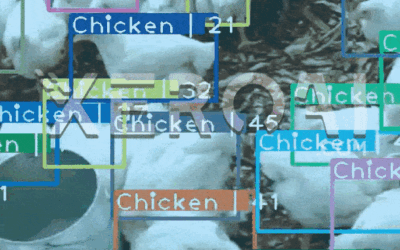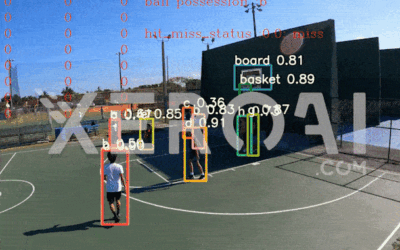1. Introduction
In the ever-evolving world of sports, the use of data-driven insights has become a game-changer, completely transforming how teams and players analyze and enhance their performance. football, a fast-paced and strategic sport, can harness the power of technology like artificial intelligence (AI), computer vision, and deep learning to gain a competitive edge. In this blog, we’ll explore how these advanced technologies are changing the way we analyze football players and teams. From understanding player moves to evaluating team strategies, AI-driven sports analysis is shaping the future of football in a big way.
2. Benefits of Football Analysis Using Cameras
Analyzing football using cameras offers numerous advantages compared to using individual sensors attached to players and the ball. Let’s delve into the various benefits of football analysis using cameras:
2.1. Cost-Effectiveness:
One of the most significant advantages of camera-based analysis is cost-effectiveness. Outfitting each player and the ball with sensors can be a costly endeavor, especially for grassroots and amateur football. Cameras are a one-time investment and can cover the entire field, making them a more economical choice.
2.2. Scalability:
Cameras can be easily scaled to cover various football pitches, from local fields to professional stadiums, without incurring additional expenses. This scalability makes it feasible for organizations of all sizes to access performance analysis.
2.3. Non-Intrusive:
Players often find it uncomfortable to wear sensors during matches or training sessions. Cameras, on the other hand, are non-intrusive and do not affect the players’ movements or comfort, allowing for a more natural game.
2.4. Comprehensive Data:
Camera systems can capture the entire football match from multiple angles, providing comprehensive data on player movements, ball trajectories, and team tactics. This depth of information surpasses what individual sensors can offer.
2.5. Video Footage:
Camera-based systems provide valuable video footage of the entire match. This footage can be used for various purposes, such as post-match analysis, coaching, and fan engagement. Fans and analysts can watch the game as it unfolds, offering a more immersive experience.
2.6. Reusability:
Sensors may need regular maintenance or replacement, adding to the overall cost. Cameras, when properly maintained, can be used for an extended period without frequent replacements, reducing long-term expenses.
2.7. Multiple Metrics:
Camera systems can capture a wide range of metrics, including player positioning, speed, distance covered, ball possession, pass accuracy, and more. These metrics offer a holistic view of player and team performance.
2.8. Player Identification:
Advanced computer vision techniques can identify and track individual players, providing data on each player’s contributions, strengths, and weaknesses. This level of player-specific analysis is challenging to achieve with sensors.
2.9. Injury Prevention:
Cameras can capture player movements and biomechanics, which can be used to assess injury risks. Coaches and medical staff can use this data to design injury prevention programs and monitor player fitness.
2.10. Real-Time Feedback:
Camera-based systems can offer real-time analysis, allowing coaches and players to receive immediate feedback during training sessions or matches. This quick feedback loop can significantly enhance performance.
2.11. Long-Term Development:
The data collected through camera-based systems can be used for long-term player development and strategic planning. Teams can identify patterns and trends over multiple seasons to refine their strategies.
3. What Are the Possible Use Cases
Computer vision and deep learning-based camera solutions open up a wide range of possible use cases in football, revolutionizing the way the game is played, analyzed, and experienced. Here are some of the most prominent use cases:
3.1. Performance Analysis:
3.1.1. Player Tracking:
Cameras can identify and track individual players’ movements on the field, providing data on positioning, speed, distance covered, and acceleration. Coaches use this information for player development and tactical adjustments.
3.1.2. Team Tactics:
Analyzing the positioning and movements of the entire team helps coaches refine tactics and strategies. It provides insights into defensive formations, attacking patterns, and set-piece plays.
3.1.3. Ball Tracking:
Tracking the ball’s trajectory and speed helps assess ball possession, ball distribution, and shooting accuracy.
3.2. Player Development:
3.2.1. Biomechanical Analysis:
Cameras can capture a player’s biomechanics, helping identify any irregularities in running, kicking, or jumping. This data is valuable for injury prevention and performance enhancement.
3.2.2. Skill Improvement:
Players can review their performance through video analysis, focusing on specific skills like dribbling, passing, and shooting to refine their techniques.
3.3. Injury Prevention:
3.3.1. Biomechanical Assessment:
By monitoring players’ movements and muscle strain, cameras can assist in identifying potential injury risks. Coaches and medical staff can use this information to tailor training and recovery programs.
3.4. Referee Assistance:
3.4.1. Offside Detection:
Cameras can assist referees in determining offside infractions, ensuring more accurate decisions during matches.
3.4.2. Goal-Line Technology:
Goal-line cameras determine whether the ball has fully crossed the goal line, helping referees make goal decisions.
3.5. Fan Engagement:
3.5.1. Virtual Stadium Experience:
Fans can enjoy immersive experiences by accessing multiple camera angles and replays through live broadcasts or mobile apps.
3.5.2. Augmented Reality (AR):
AR overlays, powered by computer vision, can provide real-time player stats, tactical insights, and interactive elements during broadcasts.
3.6. Coaching and Training:
3.6.1. Real-Time Feedback:
Coaches can receive real-time data and insights during training sessions, allowing for immediate adjustments and improvements.
3.6.2. Video Analysis:
In-depth video analysis helps coaches and players review matches and training sessions, focusing on specific aspects of play.
3.7. Recruitment and Scouting:
3.7.1. Player Assessment:
Camera systems capture extensive player data, making it easier for scouts to assess potential talents.
3.7.2. Opponent Scouting:
Teams can analyze the playing styles and weaknesses of their upcoming opponents, enabling strategic planning.
3.8. Broadcast Enhancements:
3.8.1. Virtual Graphics:
Computer vision can be used to overlay graphics on the field, such as player stats, scoreboards, and advertisements, enhancing the viewer experience.
3.8.2. Highlight Generation:
Automated systems can generate highlights from matches, making it easier for broadcasters to create engaging content.
3.9. Statistical Insights:
Data Collection: Cameras help collect data on various game metrics, including pass accuracy, shot speed, ball possession, and more, enriching the statistical analysis of matches.
3.10. Youth Development:
3.10.1. Academy Assessment:
Youth academies use camera systems to assess and develop young talents, identifying areas for improvement from an early age.
3.11. Health and Fitness:
3.11.1. Fitness Monitoring:
Cameras can track player fitness levels by assessing their speed, endurance, and work rate during training sessions.
3.12. Historical Analysis:
3.12.1. Archival Footage:
Past matches and historical footage can be analyzed to study the evolution of the game, player performance, and tactical shifts over time.
3.13. Goalkeeper Analysis:
3.13.1. Shot Analysis:
Cameras help assess goalkeeper performance by tracking shot accuracy, reaction times, and diving techniques.
These use cases demonstrate how computer vision and deep learning-based camera solutions are transforming football at all levels, from grassroots development to professional leagues, enhancing the game’s performance, analysis, and fan engagement.
4. Development of Analysis System
The development process of football analysis using computer vision and deep learning involves several key steps, including player and ball detection, tracking, reidentification, and action recognition. Here’s an overview of how these processes come together for comprehensive football analysis:
4.1. Data Collection and Preprocessing
Before we get into AI-powered football analysis, we need to collect and prepare data properly. This means recording games and practices on video, making sure the videos are good quality, and lining up the data with what’s happening in the videos. We also need to organize information about the players and teams, like their profiles, game stats, and strategies. Doing this right is super important for accurate football analysis with computer vision. The better the data, the better the analysis.When it comes to using computer vision for football analysis, where we use cameras instead of sensors on players, where we put those cameras is really important. Here are some key things to think about:
4.1.1. Field Coverage vs. Audience:
Cameras must be strategically positioned to capture the entire football field while minimizing the inclusion of the audience. Cameras that inadvertently cover more than just the field may lead to the false detection of spectators, potentially interfering with player tracking and analysis.
4.1.2. Proximity to the Action:
The placement of cameras should strike an optimal balance between comprehensive field coverage and proximity to the action. Cameras positioned too far from the field may result in reduced tracking accuracy, making it challenging to recognize players’ faces and movements. This can lead to a failure to capture critical player interactions and motions.
4.1.3. Avoiding Bird’s Eye View:
The avoidance of a bird’s eye view perspective is imperative for accurate player identification. Such an angle makes it exceedingly difficult to distinguish between players, as their distinguishing features become less visible. Side or slightly elevated camera views are typically preferred for precise player recognition.
4.1.4. High-Resolution Cameras:
The utilization of high-resolution cameras is indispensable for capturing fine details, including player facial expressions, jersey numbers, and ball movement. Higher resolution facilitates more precise tracking and recognition.
4.1.5. Multiple Camera Angles:
Employing multiple cameras strategically placed around the field enables the capture of diverse angles and perspectives. This facilitates comprehensive player tracking and provides a more holistic view of the game. Wide-angle and close-up shots can be combined to offer a comprehensive perspective.
4.1.6. Camera Stability:
The stability of cameras is paramount to prevent image blurring and ensure consistent tracking. Vibrations or shaky footage can lead to tracking errors and make it challenging to accurately analyze player movements.
4.1.7. Adequate Lighting:
Ensuring adequate lighting conditions is necessary to obtain clear and well-defined images. Inadequate lighting can result in shadowing, glare, or low contrast, all of which can hinder the system’s ability to identify players and the ball.
4.1.8. Camera Calibration:
Cameras should be calibrated to guarantee accurate measurement of player positions and distances. Proper calibration compensates for lens distortion and perspective, thereby enhancing the system’s tracking accuracy.
4.1.9. Data Synchronization:
When multiple cameras are employed, precise synchronization of their footage is indispensable. Accurate timestamps and synchronized frames ensure that events are correctly matched across different camera angles.
4.1.10. Noise Reduction:
Preprocessing steps, such as noise reduction and background subtraction, aid in eliminating unwanted elements from the footage, such as moving spectators or artifacts. This significantly improves the system’s capability to focus on players and the ball.
4.2. Key Steps in Football Analysis
The development process of football analysis using computer vision and deep learning involves several key steps, including player and ball detection, tracking, reidentification, and action recognition. Here’s an overview of how these processes come together for comprehensive football analysis:
4.2.1. Player and Ball Detection:
- Utilize deep learning models, such as Faster R-CNN or YOLO (You Only Look Once), to detect players and the football (ball) within each frame of the video.
- These models identify the presence, location, and boundaries of players and the ball.
4.2.2. Tracking and Reidentification:
- Implement tracking algorithms to follow the movement of players and the ball across video frames.
- Assign unique identifiers (IDs) to players to facilitate reidentification as they move around the field.
- Handle situations where players might temporarily leave the camera’s view and reappear.
4.3. Action Recognition:
Apply deep learning models for action recognition to analyze player and ball movements and interactions. Some common actions to recognize include:
4.3.1. Ball Possession:
- Determine which player is currently in possession of the ball. This can involve tracking the ball’s movement and identifying the player closest to it.
4.3.2. Successful or Failed Passes:
- Recognize when a player successfully passes the ball to a teammate or when a pass is intercepted or fails.
4.3.3. Successful or Failed Attacks:
- Identify instances when a team successfully advances towards the opponent’s goal or when their attack is thwarted by the opposing team’s defense.
4.3.4. Successful or Failed Defenses:
- Detect defensive actions, such as tackles, blocks, and interceptions.
4.3.5. Shots on Goal:
- Recognize when a player attempts to score by shooting the ball towards the goalpost.
4.3.6. Goals:
- Determine when the ball crosses the goal line, resulting in a goal.
4.3.6. Offsides:
- Identify instances where players are in offside positions.
4.4. Team and Individual Player Statistics
Here’s a reorganized and concise list of football match statistics and actions that can be tracked:
4.4.1. Match statistics:
- Full match statistics for both teams and individual players.
4.4.2. Successful Scores:
- Number of successful scores and the player responsible.
4.4.3. Wides (Missed Scores):
- Number of wides (missed scores) and the player responsible.
4.4.4. Successful Passes:
- Number of successful passes.
- Player who made the pass.
- Player who received the pass.
4.4.5. Unsuccessful Passes:
- Number of unsuccessful passes.
- Player who attempted the pass.
- Player who did not receive the pass.
4.4.6. Successful Blocks:
- Number of successful blocks.
- Player who executed the block.
- Opposition player whose attempt was blocked.
4.4.7. Unsuccessful Blocks:
- Number of unsuccessful blocks.
- Player attempting the block.
- Opposition player targeted for blocking.
4.4.8. Successful Attacks to Gain Possession:
- Number of successful attacks to gain possession.
- Player who gained possession.
- Opposition player from whom possession was taken.
4.4.9. Unsuccessful Attacks to Gain Possession:
- Number of unsuccessful attempts to gain possession.
- Player attempting to gain possession.
- Opposition players targeted for possession.
4.4.10. Successful Goalkeeper Blocks:
- Number of successful blocks by the goalie.
- Goalkeeper responsible for the block.
- Opposition player attempting the goal.
- Lead-up to the blocked goal (e.g., corner, pass and kick, penalty, dribble, etc.).
4.4.11. Unsuccessful Goalkeeper Blocks:
- Number of unsuccessful blocks by the goalie.
- Goalkeeper unable to block.
- Opposition player scoring the goal.
- Lead-up to the missed goal (e.g., corner, pass and kick, penalty, dribble, etc.).
4.4.12. Successful Goalkeeper Kick Outs:
- Number of successful goalie kick outs resulting in team possession.
- Goalie executing the kick out.
- Player receiving the ball.
4.4.13. Unsuccessful Goalkeeper Kick Outs:
- Number of unsuccessful goalie kick outs where the team does not regain possession.
- Goalie executing the kick out.
- Player failing to receive the ball.
4.4.14. Possession Percentage:
- Percentage of possession for each team.
- Players with possession.
- Duration of possession.
- Match phase during possession.
- Method of gaining possession (e.g., attack, pass, kick out, corner, throw-in, free kick).
4.4.15. Opposition Possession Percentage:
- Percentage of possession for the opposition.
- Players with possession.
- Duration of possession.
- Match phase during opposition possession.
- Method of gaining opposition possession.
4.4.16. Penalties Against the Team:
- Number of penalties against the team.
- Player responsible for causing the penalty.
- Player taking the penalty kick.
- Goalie during the penalty kick.
4.4.17. Penalties Against the Opposition:
- Number of penalties committed by the opposition.
- Player responsible for causing the penalty.
- Player taking the penalty kick.
- Goalie during the penalty kick.
4.4.18. Fouls Against the Team:
- Number of fouls against the team.
- Player causing the foul.
- Player fouled (if applicable).
- Player taking the resulting free kick.
- Whether the free kick resulted in successful team possession.
4.4.19. Free Kicks:
- Number of free kicks awarded to the team.
- Number of successful free kicks resulting in team possession.
- Number of successful free kicks resulting in goals.
- Number of unsuccessful free kicks where the opposition gains possession.
- Number of unsuccessful free kicks resulting in wides (missed goals).
4.4.20. Fouls Against the Opposition:
- Number of fouls committed against the opposition.
- Player causing the foul.
- Player fouled (if applicable).
- Player taking the resulting free kick.
- Whether the free kick resulted in possession for either team or the opposition.
4.4.21. Successful Goals from Penalties:
- Number of successful goals scored from penalties.
- Players taking the penalty kicks.
- Goalie during the penalty kick.
4.4.22. Unsuccessful Goals from Penalties:
- Number of unsuccessful goal attempts from penalties.
- Players taking the penalty kicks.
- Goalie during the penalty kick.
4.4.23. Total Number of Fouls:
- Total number of fouls.
- Players responsible for fouls.
- Players fouled (if applicable).
5. Conclusion
The world of football analysis has been significantly transformed by the integration of computer vision and deep learning technologies. These advanced systems have empowered teams and players with invaluable insights into their performance, allowing for informed decisions and improved strategies. From tracking player movements to analyzing possession and scoring patterns, the benefits of camera-based analysis are evident.



